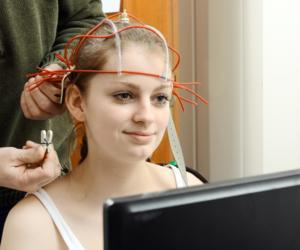Absence Epilepsy

Epilepsy is a disorder of the nervous system that causes seizures. Absence seizures, also called petit mal seizures, are brief seizures which usually last for 15 seconds or less. These seizures are so short that symptoms may not even be noticed. However, if an absence seizure is accompanied by loss of consciousness, even for a short period of time, it can be dangerous.
Children between 5 to 9 years old are mostly affected by absence seizures, but they can also occur in adults.
The symptoms of absences seizures include:
- Smacking of lips together
- Stops talking in the middle of the sentence
- Leaning forward or backward
- Staring into space
- Fluttering eyelids
- Sudden hand movements
- Being motionless all of a sudden
A child with absence seizures will appear temporarily absent from his body. The child is unaware of his environment, unresponsive to sound and touch. Absence seizures can happen suddenly, without any warnings, unlike grand mal seizures where a warning sensation or an aura is experienced prior to seizure.
Causes of Absence Seizures
The occurrence of seizure interferes with the normal brain activity. With an absence seizure, the electrical signals in the brain are being repeated. In addition, the neurotransmitters that help cells communicate are altered.
The exact cause of absence seizures is still unknown. A possible cause is genetics, where the condition is passed down from generation to generation. In other people, flashing lights and hyperventilation can trigger their seizures. While in some cases, the specific cause is not successfully determined.
How to Diagnose Absence Seizures?
If you think you have absence seizures, seek help from a neurologist. A neurologist is a specialized doctor who diagnoses and treats conditions of the nervous system, like epilepsy.
First, the doctor will evaluate the symptoms and overall health of the patient. Medications and pre-existing conditions (if present) will also be assessed. Before making a diagnosis of absence seizure, the doctor must eliminate other causes of the symptoms. An MRI may be ordered for the doctor, for more detailed viewing purposes.
The doctor may also use hyperventilation or bright, flickering lights to trigger the seizure. This test is performed with the use of an electroencephalogram which measures brain waves. Thus, changes in the brain’s function can be evaluated.
Treatment for Absence Seizures
Absence seizures can be treated with anti-seizure drugs. But, finding the right drug may involve trial and error. It could also take time. At the beginning, low doses will be given. Then, it will be adjusted based on the results of the person.
Examples of anti-seizure medications for absence seizures are lamotrigine, ethosuximide and valproic acid.
The doctor may also restrict a person with absence seizure from some activities such as swimming and driving. Because absence seizures can cause loss of consciousness, a person may drown or be involved in an accident when seizure occurs. Going back to these activities is still possible. The doctor just has to ensure that the seizure is under control.
Absence seizures don’t cause brain damage or have an effect on intelligence. Most of the time, other people are the ones who notice the seizure, as the patient is unaware that he or she having one. Get medical help as early as possible to prevent the seizures from progressing to more intense ones.













